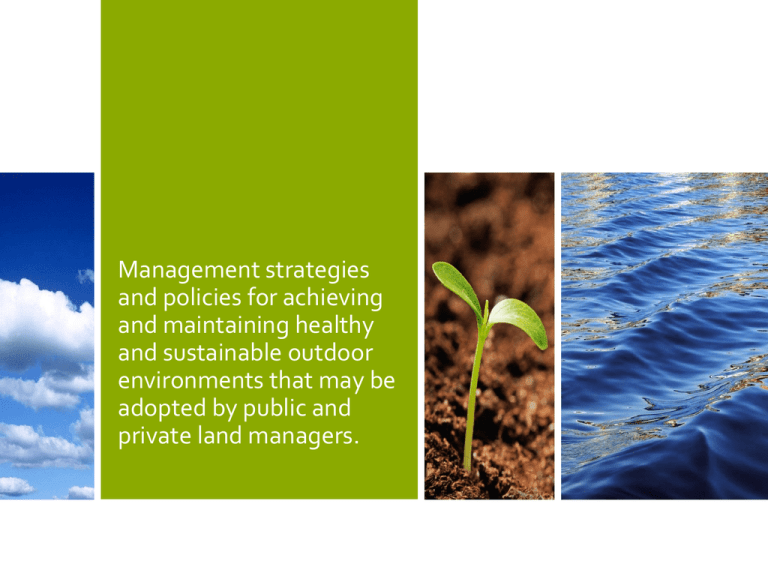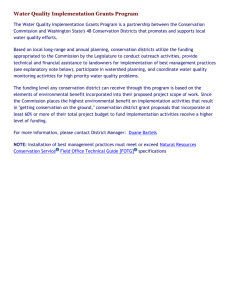4.2.4 Management strategies and policies
advertisement

Management strategies and policies for achieving and maintaining healthy and sustainable outdoor environments that may be adopted by public and private land managers. Private land management.. Trust for Nature • Trust for Nature is a not-for-profit organization that works to protect native plants and wildlife in cooperation with private landowners. • As two thirds of Victoria is privately owned, much of the flora and fauna may not be getting the necessary protection despite the need for their services such as filtrating water. • The Trust was established under the Victorian Conservation Trust Act 1972 to enable people to contribute to nature conservation by donating land or money. • Trust for Nature is now one of Victoria’s primary land conservation organizations, with several tools to help people protect biodiversity on private land. • In 1978, Trust for Nature developed conservation covenants as a way to protect native plants and wildlife on private land. Private land management: Trust for Nature Trust for Nature's vision for the future is: "There will be a shared expectation and responsibility among communities, landowners and governments that significant natural areas on privately owned land should be conserved, just as national and state parks are protected." Private land management: Trust for Nature How They Work • Conservation covenants - providing permanent protection • Trust for Nature developed its Conservation Covenant Program so landowners could permanently protect native plants and wildlife on their properties. • Conservation covenants remain one of the most effective ways to protect native plants and wildlife on private land. The covenant remains attached to the title of a property, even if it is sold. • Conservation covenants are backed by State legislation through the Victorian Conservation Trust Act 1972. (They currently have more than 1,115 conservation covenants) • The agreement is voluntary and negotiated between Trust for Nature and each individual landholder. • Each conservation covenant is then considered by Trust for Nature's Board of Trustees before being sent to the Victorian Environment Minister for approval. Private land management: Trust for Nature They have now protected more than 47,000 hectares through over 1,115 perpetual conservation covenants. The Trust has also purchased and preserved more than 55 properties across Victoria through its Revolving Fund, as well as currently owning and managing 46 properties that cover over 36,000 hectares of Victoria. Private land management: Trust for Nature Stewardship - the support program • Once a property has had a covenant placed on it, Trust for Nature will offer a Stewardship program. • Through the Stewardship Program, Trust for Nature offer conservation management advice and property maintenance tips to each landowner, helping covenanters maintain and improve the health of native plants and wildlife on their property. • Trust for Nature will also offer landowners technical advice, information about land-management incentives available to landowners, and practical assistance with land management and habitat/species monitoring. Private land management: Trust for Nature Revolving Fund - a cycle of success • The objective of Trust for Nature's Revolving Fund is to use the real estate market to achieve conservation outcomes. Funds provided through donations and by the Australian Government are used to purchase environmentally significant land, which they then on-sell with a conservation covenant attached. • The Revolving Fund is a can target the protection of native vegetation in areas where other methods are less effective, and introduce new participants to conservation through land protection. • All money generated through the sale of the properties is wholly returned to the Fund to replenish its reserves and enable future purchases. In this way the fund revolves in perpetuity. • (They have sold 47 properties through the Revolving Fund so far, protecting 5,735 hectares of Victorian bush land so far). Private land management: Trust for Nature Land Acquisition - buying back the bush • To protect native plants and wildlife, Trust for Nature buys and maintains properties with high conservation value. • This enables both the regeneration of damaged habitats and their future protection. • We also use some of these properties to demonstrate private land conservation practices. Public land management Who is the main public land manager in Victoria?? Public land management What do Park Rangers do? - Build and maintain good working relationships with farmers and landholders, tourism providers and local communities - Maintain and modify tracks and signs - Carry out surveys of heavily visited sites and damaged areas - Provide guided walks and events, give talks and educational activities for schools and the public - Respond to requests for information and advice from students, visitors, the media and tourism industry - Assist emergency services with local knowledge and expertise - Provide training for volunteers and new staff - Respond to out of hours calls to assist the public Public land management Land management approaches can include some of the following: - Creating and maintaining conservation reserves, such as national parks and wildlife sanctuaries - Developing wildlife corridors between pockets of remnant vegetation - Translocation or reintroduction of species into areas where they used to occur - Ecotourism - Contemporary indigenous land management Some general management practices may include: - regulate behavior and restrict access, duration, equipment - modify the setting of area - concentrate use or disperse use of certain areas - modify management practice and presence: install signage, raise staff profile, increase protected areas, stop land clearing and grazing in marginal and sensitive lands, control introduced species, control impact of genetically modified organisms, manage fire regimes, manage industrial pollution, monitor climate change. Public land management Recreation - Maintain and develop visitor facilities such as picnic areas, camping areas and toilets - Create and maintain trails for hikers, mountain bike riders, four-wheel driving etc - Respond to emergency situations such as ‘Search and Rescue’ - Management and development of staff, volunteers, contractors & work experience students - Delivery of interpretation and education services including guided tours, demonstrations and talks - Planning, implementation and management of projects, programs and contracts Things to do/know for the exam: Be able to describe and evaluate management strategies and practices that you’ve seen used in environments you’ve visited • What are they? • How are they used? • Are they effective or not? Strategies for the management of public land in Victoria Overview… • Maintain and modify tracks and signs • Carry out surveys of heavily visited sites and damaged areas • Provide guided walks and events, give talks and educational activities for schools and the public • Respond to requests for information and advice from students, visitors, the media and tourism industry • Assist emergency services with local knowledge and expertise Strategies for the management of public land in Victoria • Create and maintain conservation reserves • Develop wildlife corridors between pockets of remnant vegetation • Reintroduction of species into areas where they used to occur • Regulate behaviour and restrict access, duration, equipment etc. • Manage fire regimes • Control introduced species









